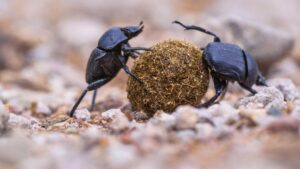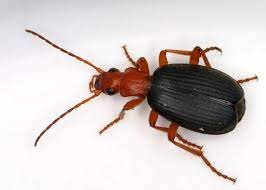Dung beetles – a fascinating subject. The insects recycle human and animal waste and thus are an important part of our lives – if they didn’t exist, we would have an enormous amount of faeces and pests everywhere and our ecosystem would collapse. This is not something I just made up, but a statement by Cypriot entomologist and ecologist Marios Aristophanous who describes the beetles as the “rubbish collectors of the natural world.”
His latest article on insects in Cyprus is currently being peer reviewed and will soon be published by an international journal. The subject:
“The moth that we discovered was previously only known from a single specimen found in 1950, it’s called Clarina syriaca, This large Hawkmoth remained undetected in Cyprus for 70 years until we recently found another individual moth and also its larva (caterpillar) proving that this species has a local population.”
His whole life led him towards an interest in insects and later to dung beetles. The now 39-year-old researcher was born in Alethrico, a village just outside of Larnaca, to parents who encouraged his interest in biology – and insects in particular.
“My father is a taxidermist and naturalist and somebody I could talk to about the subject. I learned early on about the diversity and beauty of the natural world and was fascinated by insects. They are like little ‘aliens’ with their six legs and antennae and are so variable in shape, form and colour. It’s hard to be bored as there are more species of insects than all other species on Earth combined – mammals, birds, reptiles, amphibians, fish, spiders, plants, fungi, bacteria and even viruses.”
“We are prone to have positive feelings towards other mammals, such as dogs and cats, as we can ‘get’ what they are about. Perceptions about insects are often shaped by our limited understanding of them. For example, we believe many are harmful and irritating, because what comes to mind are mosquitos that bite us and ants and cockroaches which invade our homes and are thought of as pests.”
Dung beetles have six legs and if we happen to notice them – unlikely as they do not invade our homes – may remind us of pesky cockroaches, hated by almost everybody, so there isn’t much chance of them being appreciated, despite their tremendous ecological importance.
Back to the entomologist’s personal history. When he was eight years old, his family moved to London, a huge change from the small Cypriot village, and something which forged his connection to the UK. The family returned to Cyprus in 1996, and after Marios attended Med High school in Larnaca and served in the army, he decided to study zoology and botany in Australia.
He opted for the combination of the two subjects as he was interested in ecology.
“Everything is connected, animals interact with the environment and plants, while plants rely on soil, it’s the web of life,” he said.
Which led to the study of dung beetles.
His PhD thesis investigated the drivers and predicted the impacts of future climate change on endemic dung beetle biodiversity in the Australian Wet Tropics rainforest – a Unesco World Heritage Area.
Some results of his 2014 study:
“Anthropogenic climate change is a major threat to global biodiversity, threatening many ecosystems with extinction. An understanding of the factors influencing species distribution and diversity is vital for assessing their vulnerability to climate change. This is particularly the case for tropical rainforest insects that constitute the bulk of all known biodiversity, provide many ecosystem services, and yet, remain poorly studied.”
“Dung beetles are a keystone group of great ecological and economic importance. Their feeding and nesting behaviour contributes towards many ecological functions, such as the removal and recycling of animal waste. Thus, climate change induced alterations in dung beetle biodiversity have the potential to disrupt such ecosystem services, negatively impacting proper ecosystem functioning.”
They have several ways of disposing of the waste, or food as they would call it. One group, aptly called rollers, roll the dung and transport it to a safe hiding place as can be seen here https://www.youtube.com/watch?v=xNjymt6oCcQ. In this way they are sure to have enough sustenance for their offspring.
Others, known as tunnelers, bury the dung where they find it. This ensures no other dung beetles can find it until the insects are ready to use it.
After spending two years at the National History Museum in London, helping to look after the collection of insects, and another two years at the African Natural History Research Trust, UK, organising and attending insect biodiversity surveys in the Afrotropics, the researcher decided to relocate and study insects in Cyprus.
His task is to find as many insects as possible, then name them and categorise them with the aim of creating a catalogue to which future researchers can refer.
Knowing which species occur in a particular area is the basis for all conservation work, because ultimately you cannot protect something if you don’t know it even exists, he explained.
The entomologist, armed with a research permit from the forestry department, first chooses likely locations, the more remote the better. Forests and areas around rivers are a good bet, as they tend to be the least disturbed by humans.
As we know, moths and other insects are attracted by bright light at night, so a good idea is to put up what researchers call a light-sheet, and when insects appear, they can be photographed and collected, to be prepared for scientific analysis under a microscope.
Some of his projects have been funded by the government under the LIFE project of the EU.
“The endemic subspecies I worked on during the LIFE project with the forestry department is called Propomacrus bimucronatus cypriacus, a Scarab beetle endemic to Cyprus. The aim was to identify its distribution within and outside Natura 2000 sites.”
The larvae of this species can only live and feed inside tree hollows of very old trees, especially oaks, carob, oriental plane and almond trees.
The aim of such studies is to show why vulnerable areas are in dire need of protection and help governments and universities to lobby for more funding.
“I think of the spaceship analogy when it comes to the extinction of beetles, insects and other species as the result of climate change, overpopulation and the destruction of habitats. You cut one wire, that corresponds to one species becoming extinct, then the spaceship still works, but cut more and more wires and eventually the system will collapse and your spaceship will crash. The red warning light of our spaceship is now blinking, and it is up to us to choose what we will do next”, Aristophanous told me.
He is cautiously optimistic, however, hoping more information about the lives of insects will be a catalyst for change, getting people to notice, observe them and appreciate their importance.
Beetle facts
One out of every five animals on earth is a beetle
It is estimated that there are about 7,000 species of dung beetle in the world
The origin of Australian hats with corks
The short version: there are many flies in Australia and the hats are meant to protect people from their onslaught. The dung beetle explanation: European settlers arrived in 1788 with a tiny herd of cattle. This number rapidly increased during the immediate years after settlement. By 1900, the beef cattle herds in Australia had risen to over 8.6 million. Dung beetles, however, were not ready for them, being used to processing faeces of other animals such as kangaroos. The result: flies found the perfect food, with nothing interfering with their proliferation.
Dung beetles are really good at finding faeces
When it comes to faeces, the fresher the better (at least from the dung beetle’s perspective). Once a dung pat has dried out, it’s less palatable to even the most dedicated excrement eater. So dung beetles move quickly when a herbivore drops a gift in the pasture. One scientist observed 4,000 dung beetles on a fresh pile of elephant scat within 15 minutes after it hit the ground, and shortly thereafter, they were joined by an additional 12,000 dung beetles. With that kind of competition, you have to move quickly.
They are the strongest animals in the world
Even a small ball of fresh dung can be hefty to push, weighing 50 times the weight of the determined dung beetle. Male dung beetles need exceptional strength, not just for pushing dung balls but also for fending off male competitors.
The individual strength record goes to a male Onthophagus taurus dung beetle, which pulled a load equivalent to 1,141 times its own body weight.
Ancient dung beetles existed
Because they lack bones, insects rarely show up in the fossil record. But we do know that dung beetles existed around 30 million years ago because paleontologists have found fossilised dung balls the size of tennis balls from that time.
And last but not least: beetles use chemical weapons
A species of beetle living in Cyprus known as a bombardier releases chemicals from its back-side which when mixed create a reaction described as a miniature explosion. They aim this acid mixture at their predators to protect themselves.










Click here to change your cookie preferences